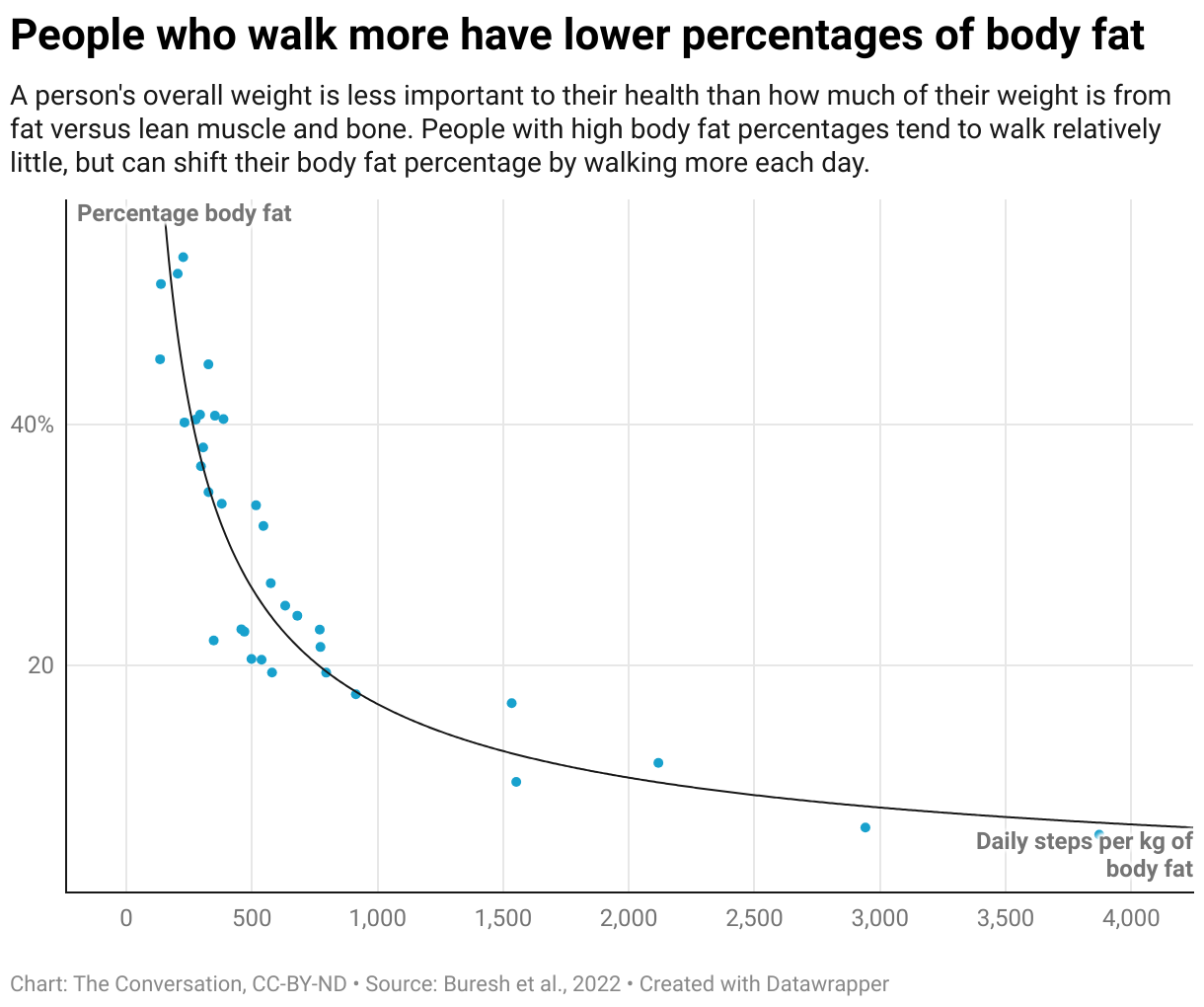Over the last decade, smartphones have become ubiquitous not just for sending texts and staying abreast of news, but also for monitoring daily activity levels.
Among the most common, and arguably the most meaningful, tracking method for daily physical activity is step counting.
Counting steps is far more than a fad: The U.S. Department of Health and Human Services dedicated a sizable portion of its most recent physical activity guidelines to documenting the relationship between daily step counts and several chronic diseases.
Unfortunately, the guidelines have little to say about how step counts might be used to aid in weight management, an outcome of critical importance given the high rates of overweight and obesity in the U.S.
In the early 1980s, fewer than 14% of adults in the U.S. were classified as having obesity. Today, just over 40 years later, the prevalence of obesity is greater than 40% in the adult population, and current trends suggest that almost half of adults in the U.S. will be obese by 2030.
I am a professor of exercise science at Kennesaw State University, and our lab has been conducting studies examining relationships among step counts and a number of health outcomes.
While the evidence is clear that increasing numbers of adults are living in a chronic energy surplus that leads to weight gain, a key question is – why? What has changed so dramatically since 1980 that could explain why obesity rates have tripled?
Although the American diet is likely a key contributor, a wealth of research points to a reduction in physical activity as a major culprit behind the expanding waist lines – and step counts are an excellent indicator of physical activity.

Step counts may – or may not – lead to weight loss
A number of recent studies have looked at whether increasing step counts can lead to weight loss over a certain period of time. One large-scale study called a meta-analysis concluded that increasing physical activity by way of step counts was effective for attaining modest weight loss. However, many if not most studies examining the effect of exercise on weight loss report modest outcomes, with results that are variable and often disappointing.
That may be in part because the step count targets used in many weight management studies are most often set in an arbitrary manner, such as targeting 10,000 steps per day. Or, if they’re individualized at all, they’re based on initial behavioral characteristics, like adding a given number of steps to what a person is already accumulating in a typical day. Rarely, if ever, are the step targets in research studies based on any physical attributes of the participants.
My team’s research has compiled weight, body fat percentages and average step counts for large numbers of adults between 19 and 40 years of age. From that data, we have identified a way to determine specific step count goals based on key physical attributes – namely, baseline body weight and composition, and the desired body composition.
When it comes to health, it is important to remember that body weight does not tell the whole story. In fact, body composition is much more predictive of health status than body weight. Someone who weighs more than another person may be in better health if they have more muscle mass and a lower percentage of body fat than the other person who weighs less but has a higher proportion of body fat.
Parsing the numbers
We have used our data to develop a model that predicts average daily step counts per unit of fat mass from body fat percentage. We believe that this model can be used to determine how much people would need to walk to achieve a specific amount of weight and body fat reduction.
Take, for instance, a man who weighs 175 pounds (80 kilograms), of which 25% is fat. Our model suggests that he walks an average of 10,900 steps a day. Then consider another man who weighs 220 pounds (100 kilograms), of which 20% is fat. Although they have different amounts of lean mass, both men have about 44 pounds (20 kilograms) of fat. So our model predicts that the heavier man walks an average of 15,300 steps a day. In other words, the heavier person has a lower percentage of body fat and walks more to maintain that leaner body composition.
A person’s body fat percentage is every bit as important as their weight. That’s because how much muscle you have affects how hungry you get, as well as how many calories you burn. Muscle mass requires energy to maintain, and this requirement leads to increased appetite, which means taking in more calories. In this example, the heavier man probably eats more than the lighter man in order to maintain his lean muscle mass, and he must walk more to maintain his lower body fat percentage.
If you want to lose body fat, and therefore weight, you basically have two choices: You can eat less, or you can move more. Eating less means you’ll be hungry a lot, and that’s uncomfortable, unpleasant and, for most people, not sustainable. Moving more, on the other hand, can allow you to eat until you’re full and keep body fat off – or even lose it.
Therefore, we wanted to know how much a person who eats until they’re full might have to move to offset the calories they’re eating.
Step counts for weight loss
Currently, our model applies to young adults, but we are now collecting data for middle-aged and older adults too. To use this model, you need to first have your body composition determined, a service that is being offered by increasing numbers of fitness centers and medical practices. With our model, you must determine your body weight and fat weight in kilograms – to do this, simply divide your weight in pounds by 2.2.
With this information in hand, our model can provide a step count target that is specific to a person’s current body weight and body fat percentage, and their goal for fat loss and weight reduction.
For example, our model predicts that a woman weighing 155 pounds (70 kilograms) with 30% body fat currently accumulates an average of about 8,700 steps per day. If she wants to lose about 10 pounds and reach a body fat percentage around 25%, she could consult the model and discover that people who maintain that body composition accumulate an average of about 545 steps per kilogram of fat per day. Since she currently has about 46 pounds (21 kilograms) of fat, her goal would be to accumulate a total of 11,450 steps per day.
While that may seem at first glance to be a sizable increase in daily steps, most people can accumulate 1,000 steps in 10 minutes or less. So even with a comfortable pace, this additional daily dose of walking would take fewer than 30 minutes. Furthermore, steps can be accumulated throughout the day, with longer or more frequent trips, or both, to restrooms, vending machines and the like.
While steps certainly can be accumulated in dedicated walking sessions, such as a 15-minute walk during lunch hour and another 15-minute walk in the evening, they can also be accumulated in shorter, more frequent bouts of activity.
Researchers have learned a great deal in the past 70 years about appetite and energy expenditure: Appetite imposes a drive for food based largely on our fat-free mass, no matter how active or inactive we are, and we must accumulate enough physical activity to counter the calories that we take in through our diet if we want to maintain an energy balance – or exceed our intake to lose weight.
This article is republished from The Conversation under a Creative Commons license. Read the original article.






